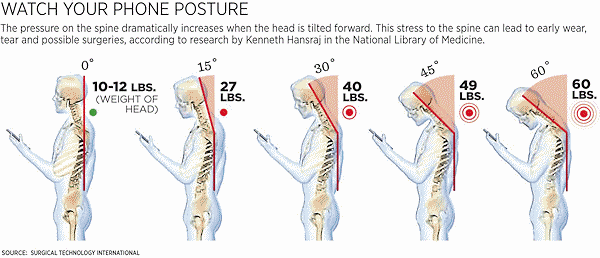Are You At Risk Of Developing Text Neck?
 Even if you may have never heard the term text neck, the chances are very good that you or someone that you know actually suffers from it on some level.
Even if you may have never heard the term text neck, the chances are very good that you or someone that you know actually suffers from it on some level.
You may find on a daily basis that you or other people that you know or come in contact with are hunching over and looking at or picking away at their mobile device. Smartphones, tablets and other hand held gadgets are all playing a big role in the posture of millions of people on a daily basis. Because they keep both hands in front of them holding their devices for a long period of time each day, the muscles and posture are starting to suffer. Over time, there could be significant consequences.
It is a term that is now being used by many for the problems that can arise with our necks from looking down at a screen repeatedly. Whether you are texting, watching videos, checking your friends out on social media sites or simply loading information into your calendars, you are bending your head and neck forward each time.
Many people do not even realize the impact that they are having on their cervical spine and posture. Of course, when you are right in the middle of a movie or game, the last thing you are going to be thinking about is the kind of posture that you are maintaining.
- A 2019 study in Telemedicine Journal & E-Health on university students found symptoms of musculoskeletal pain regarding typing method on smartphones. Almost half reported neck pain. The authors found those who typed with the head at 45 and 60 degree angles are two times as likely to report higher scores of severe symptoms than those who type with their neck at 0 degrees – neutral anatomical position.
The authors concluded. “Within the university student population the typing position on a smartphone and time of use are associated with the presence of pain in the cervical region.”
How To Help Text Neck
If you already have neck problems, you are probably aware of the pain it may cause, however, many are young and will not take seriously the long term damage it can cause like degenerative disc disease and chronic muscle strain.
If you do not want to cause permanent damage, you should know that there are a number of exercises that you can try. Should you already be noticing that you are having a level of pain or discomfort in your neck throughout the day, it is important that you start trying these exercises immediately. The more aware you are of the problem, the better chance you have of taking the time to work specific muscles that can help. Work on the nodding exercise that is simple to do and produces great results.
- A 2017 study in the Journal of Physical Therapy Science found simple neck exercises, as we promote, improved forward head posture due to smartphone use in only 4 weeks.
- A 2020 study in the Journal of Orthopaedic Science found in 2438 young chronic neck pain patients, excessive smartphone use may cause cervical disc degeneration that can lead to cervical spondylosis.
- A 2021 study in the journal Work found neck discomfort and pronounced neck flexion have been associated with smartphone use. Eye glasses with a 90 degree prism in each lens offered an alternative way of interacting with a smartphone while texting in stationary postures. This, reduced exposure to pronounced flexed neck and head posture commonly seen in users, and could reduce neck discomfort associated with smartphone use.
- A 2020 study in the journal Motor Control found that in addition to distraction, texting while driving threatens safe driving performance by affecting postural stability, especially in older adults.
- A 2020 study in PLoS One found using a smartphone while walking had a negative effect on walking parameters such as walking slower and with less velocity, altered stride length and gait cycle. Additionally, they spent more time in contact with the ground. This was noted as a texting posture and the same results were seen assuming this posture even without using a smartphone.
- A 2020 study in Human Factors found neck muscle activation using a smartphone during walking was up to 41.7% higher than sitting and standing. The head posture was flexed more significantly higher neck extensor muscle activation when texting compared to browsing. Two handed texting while walking is the most physically demanding for neck muscles and related to walking with the head facing downwards.
- A 2020 study in Nigerian Journal of Clinical Practice used MRI and found an association between smartphone use in young adults with neck pain and the rise of disc degeneration with associated Modic changes as well as cervical spine imbalance.
- A 2021 study in Archives of Physiotherapy found the most prevalent symptom of smartphone and tablet users was neck stiffness. Tablet users 18 to 24 years old using the device for more than 30 min a session experienced symptoms more often than those using for 30 min or less. The authors concluded, “If usage was capped at [less than] 15 min, the majority of smartphone and tablet device users would avoid symptoms.”
 The main thing that you can do if you are worried about developing text neck is to learn about ergonomics. This gives insightful options and awareness of the problem that you may recall each time you grab your mobile device. Instead of slumping forward to read a message or respond to a text, try to correct your posture and bring your phone up to your face instead of the opposite. This also keeps your field of gaze forward to avoid accidents. Even the smallest gesture and remaining aware of your posture can have a great impact on the way that you will feel over time and keep you from suffering from the text neck epidemic.
The main thing that you can do if you are worried about developing text neck is to learn about ergonomics. This gives insightful options and awareness of the problem that you may recall each time you grab your mobile device. Instead of slumping forward to read a message or respond to a text, try to correct your posture and bring your phone up to your face instead of the opposite. This also keeps your field of gaze forward to avoid accidents. Even the smallest gesture and remaining aware of your posture can have a great impact on the way that you will feel over time and keep you from suffering from the text neck epidemic.
- A 2021 study in Mhealth indicates text neck is a definition used to describe stress injuries and neck pain resulting from an incorrect smartphone use and for excessive periods of time. It replaces the term turtle neck (used for the same problems) because it is more directly related to typing activities (texting) and also seen with web browsing. Symptoms range from headache up to cervical disc herniation.
Experts recommend to relieve stress due to posture, simple changes in lifestyle like keeping the devices in front of the face or at eye level while watching the display and use both hands and the two thumbs to create a more balanced and comfortable spine position, as well as stretching exercises and other posture correction methods.
- A 2021 case report in Adolescent Health, Medicine and Therapeutics indicates an 11 year old girl presented with neck pain and dizziness for four months. According to the patient’s statement, her complaints were likely related to the prolonged smartphone use for texting. The authors indicate, “The immature growing cervical spine has unique anatomic, physiologic and biomechanical features. A static neck flexion can lead to typical injury patterns seen in this age group.”
Static, flexed neck posture from excessive texting on a smartphone can cause the neck muscles go into painful spasm. Neck perception and joint position sense are impaired as well by altered, joint mechanics, or joint capsule sensitivity and by disruption of the afferent proprioceptive tuning to the vestibular nucleus that may contribute to a sensation of unsteadiness.
- A 2023 study in BMC Musculoskeletal Disorders indicated frequent smart phone forces the user to adopt a compromised posture resulting in changes to both the postural and musculoskeletal systems. The authors found a correlation between smartphone addiction and both changes in neck postural alignment and decreased neck extensor muscle endurance.
- A 2023 study in Musculoskeletal Science & Practice demonstrates smartphone use affects gait performance, spinal kinematics and causes spinal musculoskeletal discomfort in young adults. This was noted during sitting, standing and at the end of a 3 min-walk, as well as on the parameters of gait.

